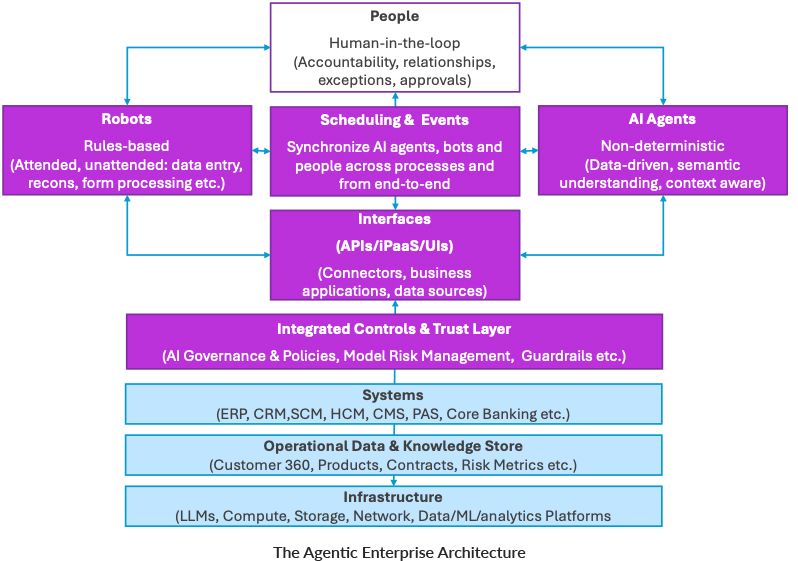When AI Agents First Arrived
When we first started building AI agents at I&M Bank we were wowed by how much they could do.
The agents could capture and validate data, transform it, make decisions, and take action. They acted with a degree of autonomy that shook process design free from rules-based linear steps. They handled ambiguity. They navigated back and forth in non-deterministic scenarios.
Why Not Every Task Needs Sophisticated Tech
But soon we asked: “why would you pay a doctor to sit at reception?” Not every task needs the smartest - or most expensive - technology.
Robotic Process Automation (RPA) is great for what it does: reliably handling repetitive, rules-based tasks at scale, driving efficiency and freeing people from mundane work such as data processing. But it has its limitations: it depends on digital inputs and structured data, and it can only execute deterministic logic.
Where Intelligence Takes Over
For many high-value and complex use cases, structured rules aren’t enough - you need intelligence. That’s where large language models (LLMs) and other AI models come in. At the core of smarter end-to-end design, they provide the raw intelligence: the ability to interpret language, classify information, reason over context, and generate responses. With agentic, we turn LLMs into large action models.
Applying Intelligence Through the Right Tools
The most effective and cost-efficient process solutions combine automation with intelligence - with RPA handling structured, repetitive work, and AI-enabled tools enabling adaptability, reasoning, and judgment:
- Digital interaction channels (forms, portals, apps) to capture and pre-populate data, trigger fulfilment, and improve the customer experience.
- Conversational agents to guide interactions and drive them toward the right decisions.
- Intelligent Document Processing (IDP) to extract data from unstructured formats and turn it into actionable information.
- RPA to handle repetitive, rules-based tasks.
- AI agents to manage non-rules-based work - verifications, complex decisions, and autonomous judgment calls.
- Custom code for lightweight decision points and tailored data manipulation.
- Humans for oversight, empathy, creativity, and those moments where human judgment matters most, when people should do what people do best.
- APIs/iPaaS to connect seamlessly with systems and data sources.
- Agentic orchestration to synchronise the work of robots, AI agents, and people.
This architecture can be assembled in a bespoke way - or taken out of the box with an agentic automation platform such as UiPath - enabling organisations to move beyond automation into intelligence-driven transformation
Together, these capabilities don’t just streamline processes - they enable us to reimagine them. Instead of rigid, step-by-step activities bounded by organisational silos, we can create a dynamic, adaptive flow of data capture, validation, transformation, decision-making, and action.
A New Operating Layer Is Emerging
This marks a fundamental break from IT architecture and business operating models as we know them. Business logic is no longer hard-wired into legacy applications; instead, it shifts into an ecosystem of AI, automation, and human judgment. In the near term, AI and automation interface with legacy systems, orchestrating the functionality they still provide. Over time, agents won’t just support decisions - they will orchestrate them, shifting the role of legacy systems from engines of operation to trusted data and transaction stores.

Two Transformations You Can’t Ignore
The result of the careful application of AI and automation? Two powerful transformations:
- Processes reimagined – to be faster, cheaper, more accurate, and more compliant - delivering better outcomes for both customers and employees.
- The rise of the agentic enterprise - where people, AI agents, and robots work together seamlessly for always-on, agile, and highly productive operations.
A sound business case underpins these transformations. Grounded in automation, this delivers operational efficiencies and cost savings. Enabled by AI, it drives improved customer experience and revenue growth.
Avoiding the RPA Mistakes of the Past
In the early days of RPA, many organisations fell into the trap of automating discrete tasks - delivering efficiency gains, but often with limited strategic value. This was compounded by deploying robots within silos and tying them to specific tasks, creating islands of automation. With agentic, we cannot afford to repeat that mistake. The opportunity now is not to bolt intelligent tools onto outdated workflows, but to reimagine entire end-to-end processes - so that automation, AI, and human judgment combine to unlock maximum value. This success is then amplified by re-using AI agents and automation objects, and by orchestrating processes across the enterprise, enabling always-on, agile operations.
The Opportunity is Clear:
- Rethink your processes.
- Rethink your operating model.
- Let AI agents and robots do what they do best.
- Let people do what they do best.
Thanks to the vision of leaders like @Jamie Loden, the COO at I&M Bank, this is no longer theory - the agentic enterprise is underway.
Over to You
What do you think - are you exploring your own path to the agentic enterprise?”


